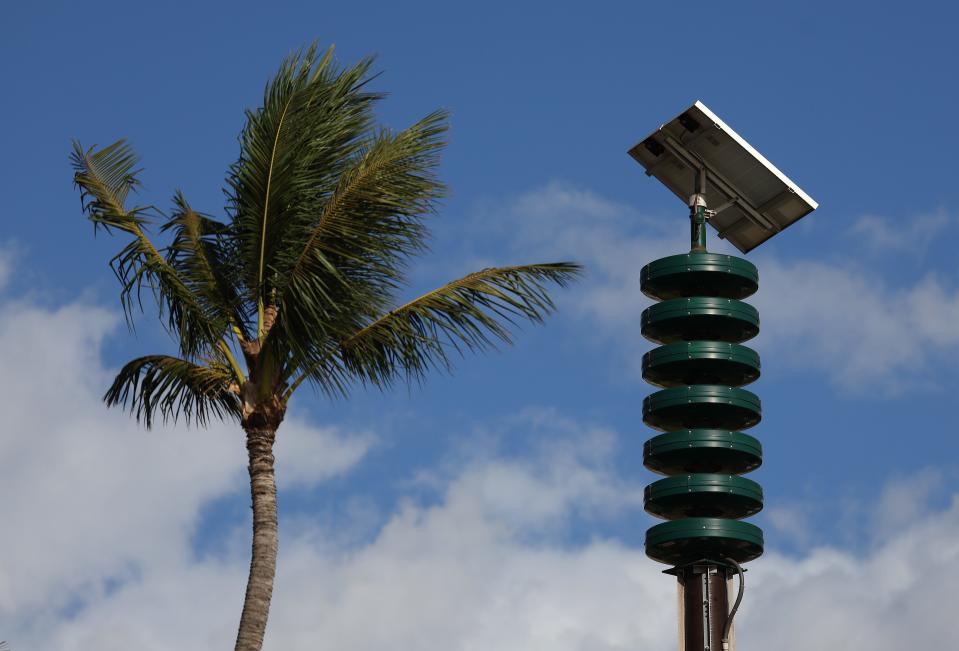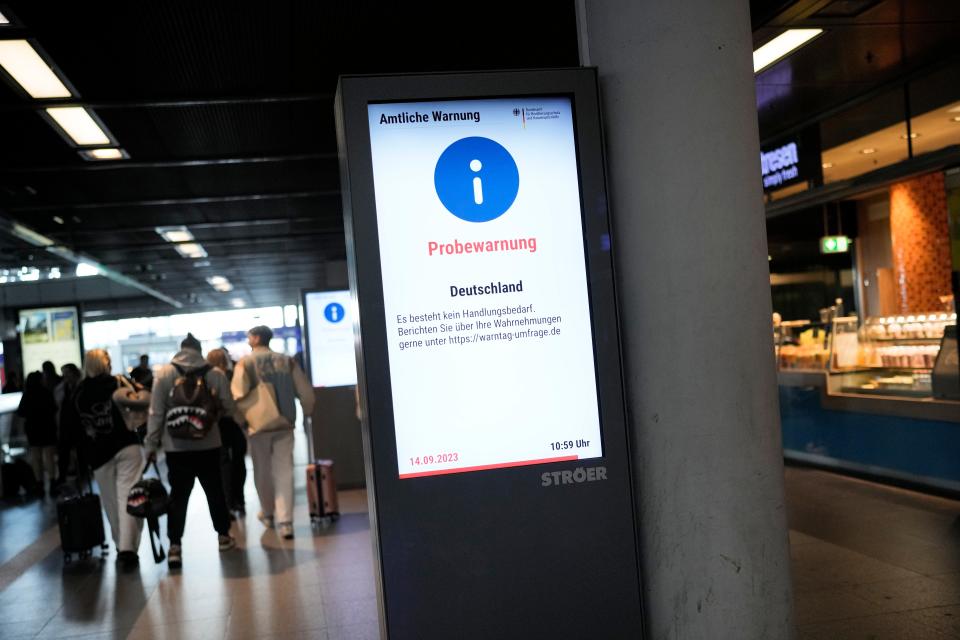Massive emergency alert test scheduled to hit your phone on Wednesday. Here's what to know.
Get ready to not freak out. On Wednesday, Oct. 4 at 2:20 p.m. EDT, every TV, radio and cellphone in the United States should blare out the distinctive, jarring electronic warning tone of an emergency alert.
It's a test – only a test.
Officially, the trial is called the Nationwide Emergency Alert Test. You know it's a test and not an actual emergency because it's accompanied by an explanation of the test.
No, it's not a national conspiracy to infect people with nanoparticles. Yes, it does go back all the way to the Cold War in the 1950s. No, we can't play you the tone – we could get hit with a big fine if we did.
But mostly the test is an important way to make sure that if something really bad – and really big – happens, Americans can be warned quickly.
Here's what to know about the test:
What is the emergency alert test? How does it work?
The national test consists of two parts, which occur in conjunction with one another, in order to test the Emergency Alert System and the Wireless Emergency Alerts, according to FEMA.
The WEA will be directed to all cellphones, while the EAS will notify all radio and television broadcasters, cable systems, satellite radio and television providers and wireline video providers.
The message will be heard and seen pretty much everywhere. It's being conducted with the participation of radio and television broadcasters, cable systems, satellite radio companies and cellphones networks.
What will the emergency alert test message say?
All across the United States, broadcast TV shows and radio will be interrupted as the emergency message goes out. That message will say:
“This is a nationwide test of the Emergency Alert System, issued by the Federal Emergency Management Agency, covering the United States from 14:20 to 14:50 hours ET. This is only a test. No action is required by the public."
Cellphones will get the warning as a tone, a vibration and as a text message:
“THIS IS A TEST of the National Wireless Emergency Alert System. No action is needed.”
Phones on which the main menu set to Spanish will see this: “ESTA ES UNA PRUEBA del Sistema Nacional de Alerta de Emergencia. No se necesita acción.”
When will the emergency alert test happen?
The alert will air at the same moment across every time zone in the country starting at 2:20 p.m. EDT on Wednesday, Oct. 4. The time will vary across time zones, so look to see when you might be alerted.
2:20 p.m. EDT
1:20 p.m. CDT
12:20 p.m. MDT
11:20 a.m. PDT
10:20 a.m. ADT
8:20 a.m. HST
The test is scheduled to last approximately one minute. It will only go out once, there will be no repeats.
Will you get the message if your phone is turned off?
Only cellphones that are turned on will receive the message. If your phone is on but the sound and vibration features are turned off, you'll still get the message.
If your phone is set to Wi-Fi or airplane mode, it won't receive the alert because the message goes out over the cellular broadcast system.

How loud will the alert be?
The type of noise and general volume of the alert is similar to that of an Amber Alert or warnings issued by the National Weather Service in case of severe weather.
The WEA alert, which will be sent out to all cellular devices will be accompanied by a unique tone and vibration to make sure that the alerts will be available to the public, including people with disabilities, according to FEMA.
Why do we need a national emergency warning test?
Federal emergency management coordinators need to make sure the national alert system is still an effective way to warn Americans about emergencies, natural catastrophes, attacks and accidents at the national level.

What will the emergency alert test sound like? We can't tell you.
The people who run the test want to make really, really sure if you hear the warning tone you know to pay attention.
Because of that, it's against federal law to play the emergency warning Attention Signal, or a recording of it, in any circumstance other than an actual emergency or authorized test.
In 2021 a proposed fine of $20,000 was levied against "The Doug Bashman Radio Show" for playing the Emergency Alert System Attention Signal "in the absence of any actual emergency." In 2019, the CBS television show "Young Sheldon" was hit with a proposed fine of $272,000 for playing a tornado warning sound effect.
Playing the tone when there isn't a real emergency or a real test could lead to "alert fatigue" where the public becomes desensitized to the alerts and stops paying attention to them, the Federal Communications Commission said in a statement about the radio show fine.
All we can offer is this, the official description of the warning tone:
"The audio attention signal must have a temporal pattern of one long tone of two (2) seconds, followed by two short tones of one (1) second each, with a half (0.5) second interval between each tone. The entire sequence must be repeated twice with a half (0.5) second interval between each repetition."
How does the emergency test go out?
The wireless emergency warning goes out over the internet and a backup through Public Broadcasting System stations. It originated at the Federal Emergency Management Agency, working with the Federal Communications Commission. FEMA sends it out over virtual private networks to television and radio stations and to US cellular companies. Each of those entities then sends the message out to their customers.
There's a backup system, in case for any reason that doesn't work, and it involves PBS – this is where the public in Public Broadcasting Service comes in.
The emergency message signal also goes out to PBS's Warning, Alert & Response Network via datacast. "We put it up onto our satellite and our interconnected system and we are able to get every single alert to every single public television station across the country," said Dana Golub, vice president of Technology Business Operations and executive director of the WARN system.
Each of the more than 330 PBS stations nationally is connected to the cellphone carriers' data centers in their area and sends the warning message to them as well. This means cellphone companies get two test messages, the system design ensures that only one goes out. If for any reason there was a hiccup in the internet and the first warning didn't reach the cell carrier, the alternative warning from the local PBS station is available as a backup.
Could the test harm people with hearing aids?
Many people with hearing aids now have them connected to their cellphones so that the audio from phone calls comes into their hearing aids via Bluetooth. There have been some online postings suggesting the loud warning tone could be harmful.
However it's not really a concern, said D'Anne Rudden, a doctor of audiology at the Longmont Hearing and Tinnitus Center in Longmont, Colorado.
"There are output limiters on hearing aids, so even though you're getting amplification there's a ceiling, they won't exceed levels that are potentially damaging to your hearing," she said.
Emergency alert test is not a conspiracy theory
There are conspiracy theories on social media suggesting that the warning tone will somehow turn on technology that has been implanted into American's bodies, putting them under some sort of "control."
These claims are untrue. The test cannot harm people and is only to verify the national alert system is working.
How long have these warning tests been happening?
The first national emergency broadcasting system in the U.S. was created in 1951 as a way for the government to use radio networks to warn the nation of an enemy attack during the Cold War. It was further refined and expanded as fears of nuclear attack grew in the 1950s and 60s.
The first nationwide test of the most recent version of the Emergency Alert System took place on Nov. 9, 2011, at 2:00 p.m. EST. The test on Oct. 4 will be the seventh nationwide test sent to radios and televisions, the third to consumer cellphones and the second to all cellular devices.
Are there ever false alarms?
Over the years there have been mistaken messages sent out that triggered false alarms at the local level, especially in the 1950s when the system was new and communication more difficult.
The most recent high profile false alarm occurred in 2018 in Hawaii when the Hawaii Emergency Management Agency system mistakenly sent an alert notification warning of a ballistic missile threat to the Islands. During a shift change, someone had selected the wrong item on a computer.
The message read, "Ballistic Missile Threat Inbound To Hawaii. Seek Immediate Shelter. This Is Not A Drill." Some state highway signs also noted the warning.
It took 38 minutes to clarify that the alert was due to user error.
This article originally appeared on USA TODAY: Emergency alert test is coming: When is the test? What will it say?


